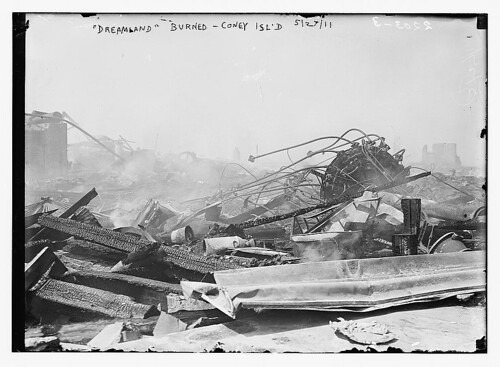
In 1905, a novel attraction opened at Coney Island’s Dreamland. “In ‘Hell Gate,’” the New York Tribune confided, “the visitors will be carried in an ingenious boat ride to ‘subterranean depths.’” Thrust out on an iron pier, Dreamland jutted into the Atlantic. But no matter that water coursed below; the specter of drowning was forced above. The start of “Hell Gate” was “made in open boats, which circle round the inclosure, and when the centre of ‘Hell Gate’ is reached the boats disappear, presumably swallowed up by the vortex of onrushing water.” The vortex swallowed again and again, drawing tourists and curious New Yorkers to witness its insatiable gape. The falsified sea, compacted, wreaked havoc in safety. The underworld haunted Dreamland.
When Luna Park opened for the season in May 1910, a new spectacle mesmerized. “‘Havana,’” the New York Times reported, “is another illusion based on the tragic fate of the old battleship Maine.” The illusion opened “with the Maine at anchor, the bluejackets skipping about her decks, and everybody having a good time.” But good times were fleeting: before long, “night comes, and suddenly there is an explosion. The Maine goes down, and the sailors are seen trying to escape.” In the attraction, the “murky waters” of Havana Harbor were reproduced lovingly. Every performance ended tragically: the ship sank into the mud.
At the turn of the twentieth century, the coastline of Coney Island harbored a number of amusement parks. Luna Park, Steeplechase Park, and Dreamland all contained mechanical wonders, thrilling rides, and human monstrosities. Though the parks arrayed themselves along a corridor descriptively named “Surf Ave.,” each destination was determined to cordon itself off from insidious advance of the ocean. Thus protected from pounding waves, profiteers crowded the parks with bottled shipwrecks.
Illusory tragedies evoked delight. In a 1928 article about Coney Island's “special brand of romance,” the New York Times mused that “The strange fact about people is that they want to think they are going to get hurt, and yet know they are not.” Amusement parks at Coney Island presented safety cloaked in danger—a sure antidote to New York City's brand of danger cloaked in safety. At least, this was the remedial relationship drawn by Rem Koolhaas in Delirious New York, his 1978 exposition on the metropolis and its cures. Dreamland, in his estimation, distinguished itself by producing a “series of simulated disasters...a psychological addiction for the metropolitan public.” The public, in his eyes, sought refuge in the catharsis of peril: “Each nightmare exorcised in Dreamland,” according to Koolhaas, was “a disaster averted in Manhattan.”
Coney Island has long been defined in opposition to the commotion of the city. Accessible by subway and yet still otherworldly, its seashore basks in the salt breeze—out of the shadow of skyscrapers. Koolhaas wrote that Coney was “the logical choice for Manhattan's resort: the nearest zone of virgin nature that can counteract the enervations of urban civilization.” Its suitability, of course, proved to be its undoing: in 1883, “the Brooklyn Bridge removes the last obstacle that has kept the new masses on Manhattan: on summer Sundays Coney Island's beach becomes the most densely occupied place in the world.” Facing debasement, Coney Island’s architects chose transcendence. “To survive as a resort—a place offering contrast—Coney Island is forced to mutate; it must turn itself into the total opposite of Nature, it has no choice but to counteract the artificiality of the new metropolis with its own Super-Natural.” The Coney Island experience was re-imagined as one of periodic immunization through sensory overload. The city paled in comparison.
And yet, though Coney has always been Manhattan’s salvation, every effort to comprehend it is confounded by setting city against island. Any such juxtaposition obscures the larger struggle. For although Coney Island did mightily resist the advances of urbanization on one side, it had no choice but to tirelessly resist the encroachment of the ocean on the other. Miles of seacoast threatened to slip away at any moment; Coney was a pleasure zone whose edges were fragile and treacherous. The ocean defined it. Often, the ocean defied it.
If Manhattan offered danger cloaked in safety, and Coney’s amusement parks presented safety cloaked in simulated danger, the Atlantic confronted the island with danger for danger’s sake. No risks taken, no monstrosities built: the ocean soothed because it was heartless and fair. It menaced not by design, but by nature. Manhattan, according to Koolhaas, was “an accumulation of possible disasters that never happen”; an infinite drama produced by an “invention in urban theatricality: the anticlimax as denouement, the non-event as triumph.” Coney Island’s coast was the opposite. Alongshore pulsed the potential for disasters that did happen, constantly. Bathers drowned, tornados devastated, tents flooded; Coney Island’s coastline was a margin of true calamity. In the rhythmic undulation between terror and relief throbbed Coney Island’s secret allure: the arrest of unbidden reality, thrilling as it menaced and breached; breaking in towering waves against the shore.
On May 27, 1911, reality breached. At 2:15 a.m., flames started near Dreamland’s power house, and “their spread was so rapid, under the impetus of a brisk breeze that swept in from the ocean, that in fifteen or twenty minutes it became apparent the entire place was doomed.” As the sea breeze urged the fire inland, the surrounding water quietly watched. The New York Tribune insisted that “the waters of the ocean gave back a ruddy glare.” In waves, from the ocean inward, the flames overtook. By the time dawn broke, Dreamland was in ruins. Later, observers would claim that the first sparks started at an exhibit called “The End of the World.” Fanned by the sea, incited by artifice; the Dreamland fire was the end of an era. In the years that followed, artifacts of artifice would slowly return to the land.
In the end, what nightmares were exorcised at Dreamland? The nightmare of catastrophe was certainly allayed by the rhythmic rendering within Dreamland of fictionalized real-world disasters. If such disasters could be fake, they might never be real again. And yet, ironically, that precipice harbored the nightmare that Dreamland ultimately exorcised for good. For if the fleeting triumph of Dreamland was an affront to the ocean, its reclamation by fire was Coney Island’s revenge. The idea that an elemental force might overcome any built landscape or social milieu was petrifying. But the idea that humans might have conquered such a threat, through their assiduous construction of skyscrapers and the meticulous building of pleasure exhibits, was even more disappointing. Beachgoers fled to Coney Island not only to escape the city, but to move toward the sea: to commune with something larger and more elemental than themselves. Spectacular calamity along the coastline of Coney Island served as a comforting reminder that the world was still governed by majestic caprice. At the end of the world, anything might happen.
* * *
Excerpted from a longer paper I recently wrote, on spectacular calamity along Coney Island's coastline.
Previously:
Bring Your Own Buttons



No comments:
Post a Comment